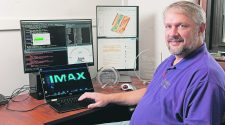BLACKFOOT – Premier Technology founder Doug Sayer vows he is not going to let a competitor surpass his company, as he says it’s 23 years old and still flying forward.
On Wednesday, the Blackfoot company presented what was called yet another “state-of-the-art” project by Idaho Gov. Brad Little, a guest at an open house. The $15 million expansion to the Blackfoot facility allows for a fully automated process for the handling, storing and cutting of raw materials.
“I’ve been trying to figure out how to describe it,” Sayer told the audience. “But I think today is the day that we graduated from being a fabrication shop into a factory.”
Premier has around 300 employees and considers itself a service-engineering, manufacturing and construction-management company. Rep. Mike Simpson, R-Idaho, also attended the event.
It is far from the first time government officials have shaken hands with Sayer or patted him on the back. Former Gov. C.L. “Butch” Otter lauded him in a state of the state address, for example.
“Every time I come here, he’s got some new state-of-the-art toy. His toys are getting bigger and more expensive,” Little told the audience. “The equipment he’s going to turn on here in a minute is reflective of a lot of things that takes place in the state of Idaho. We started out as an old mining, timber, agricultural, kind of old manufacturing (state). And almost at a break-neck pace, we’ve converted into a modern manufacturing, high-tech state.”
So how does Premier remain “very adaptive” and produce “incredible growth,” as Little told the Journal?
“My philosophy is you have to be on the leading edge all the time, especially in our business because it’s so competitive,” Sayer said. “I believe if you’re not growing and you’re not investing in your people and in new technology, you’re eventually going to find yourself out of business.”
Sayer got into business by founding Premier in 1996, starting with just a handful of staff members.
“It’s really a nice story,” Sayer said. “It should be an example to other people that you can start with very little and if you work hard enough, you can grow and you can become whatever you can imagine.”
So how does he become someone who can create a company that’s consistently progressing and prosperous?
“I’ve always said, everything I know about business I’ve learned on the football field and wrestling mat,” said Sayer, who played football for four years and wrestled for three in high school. “I enjoy that challenge and that struggle and the opportunity to win.”
While on the gridiron and mat, he also received what he said was a pivotal education in middle and high school in Wisconsin.
He called the schools in the Midwestern state “super schools” with college-esque class sizes of around 50 people.
Knowing the benefits of an excellent education, it is important to him that Idahoans receive a good one. In his opinion, they aren’t. He graded Idaho’s K-12 educational system a “C-“ or “D+.”
Idaho’s educational infrastructure is not a subject that just recently captured his attention.
Sayer spoke with the Journal in 2011 about developing more opportunities for Southeast Idahoans in post-secondary education to complement what is being offered at Idaho State University.
His suggestion to improve matters at the K-12 level in Idaho is combining public school districts, which would theoretically increase resources.
He noted that Idaho has more school districts than Utah, Wyoming and Nevada combined. The Gem State has 115 districts – 98 more than Nevada, 74 more than Utah and 67 more than Wyoming.
“We have to fix it. Educators need to get together,” Sayer said. “We need to be open to changing the way we’re educating. We need to be finding and copying and robbing and stealing the very best programs, and our children deserve the best.”
The 56-year-old can still recall his teenage years in Wisconsin, where he took mechanical drawing classes from middle school through his third year in high school. As a junior, he drew full-fledged house blueprints compliant with building codes.
“I enjoyed it. I had the aptitude for it,” Sayer said. “I could draw. I understood how to draw the blueprints, the plans, the design, and I really enjoyed the creative aspect of the whole process.”
In the addition to the wrestling mat and football field, that classroom was another place in which helped him develop into the person he became.
“If I hadn’t had that opportunity, I would have gravitated toward something different,” Sayer said. “Being able to design things and draw them – that helped me hone my skills to imagine things and then actually construct them.”
















